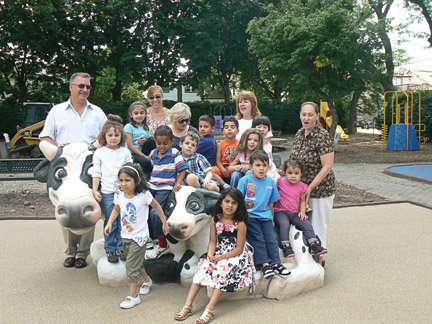A disagreement between the town of Secaucus and Freeholder Bill O’Dea over whether the town can collect parking fees from visitors to the “Field Station: Dinosaurs” theme park in the county’s Laurel Hill Park has been resolved in the town’s favor.
After a debate between O’Dea and Mayor Michael Gonnelli at Tuesday night’s Board of Freeholders meeting, the board took no action to stop the municipality, allowing them to continue collecting a $10 per car “environmental fee,” from which the town will get $6.80 for open space projects. The rest of the money goes to Field Station to pay for the parking attendants.
The county gets none of that money, even though the exhibit is in a county park. However, the county is already receiving funding from their lease agreement with Field Station over use of the county land.
“Our parks are open to everyone.” – Michael Gonnelli
____________
O’Dea was under the impression that there wouldn’t be a parking charge because it was not mentioned in the lease agreement, and questioned the process and conversations that led to the agreement.
Dispute on how much town gets vs. county
“I understand the town of Secaucus’s desire to derive some revenue from that project. I don’t have a problem with that,” said O’Dea during the meeting. “I feel that the county government is being shortchanged in the process.”
O’Dea said the approval process for the dinosaur park was “rushed.” He noted that the lease agreement negotiated by the Hudson County Improvement Authority was not presented to the freeholder’s contract committee. He felt the $10 charge was excessive and compared the dinosaur park experience to going to see a movie.
He said the town had a right to 15 percent of a parking fee but no more, and agreed to concede up to $100,000 per year to the town, but felt the county should also receive a portion of the “environmental fee.” At the high end, the parking fee could generate over $450,000 in revenue, according to a scenario presented by O’Dea, which would exceed what the county gets annually for the property lease.
Gonnelli said “the town of Secaucus provides a lot of services to county properties at zero cost.” He noted that the town police and fire have to respond to the dinosaur park if there is a fire, or security issue, or to deal with traffic.
Gonnelli also had transcripts from a county Planning Board meeting in February where a parking fee was discussed 86 times.
“You got a lease for $330,000 a year for a piece of property that was sitting there vacant,” said Gonnelli.
Freeholder Albert Cifelli said he didn’t see why the county would pursue a “piece of that pie” in going after the Dinosaurs parking fee, and a few other freeholders agreed. Freehold Board Chairperson Eliu Rivera said that he saw nothing wrong with Secaucus collecting the environmental fee since it will help pay for open space facilities.
“We are going to use it to improve parks…our playgrounds…our athletic fields,” said Gonnelli. “Our parks are open to everyone.”
Adriana Rambay Fernández may be reached at afernandez@hudsonreporter.com.
SIDEBAR
New playgrounds across town
The dinosaur park fees support improvements that are part of a town-wide initiative to update every park before the next election in 2013. Millions have been dedicated to bringing the municipal playgrounds and fields up to date, an investment the mayor and Town Council deem worthy, and one they have sought to cover in grants, loans, and contributions.
The improvements to the parks and open spaces total approximately $2.6 million. An estimated $642,000 of that has been paid for by grants or contributions. Hartz Mountain updated Snipes Park for an estimated $300,000. The town used $183,000 from a settlement with Baker Properties to pay for the Mill Creek upgrade. A county open space grant of $165,000 covered the enhancements to Ivanoski Park.
“Whenever you spend this kind of money [it is] investing in the town,” said Gonnelli. He compared it to investing in a house.
The town will bond about $500,000 for the remaining upgrades, which it expects to repay with grants and monies collected from the dinosaur park environmental impact fee.
Many of the parks in town had playgrounds that were 50 years old, according to Gonnelli. Before the rubberized surfaces were installed, wood mulch and sand covered the ground. The upgrades also bring the parks up to date on safety standards.
Naters Park on Blondel Drive, Mill Creek Point Park, Ivanoski Park at Charles Street, and Snipes Park all have new playgrounds while Trolley, Eckel, and Smit Parks are scheduled to get new ones this year. Mill Creek has tree-themed features while Trolley will get a pirate ship, which is being paid for by PSE&G.
The town has also invested in updating recreational spaces such as adding a meditation garden to the open space behind the Recreation Center; new fencing, shaded areas, and other features to the outdoor Swim Center; and completely updating Shetik Field with synthetic turf, new basketball and tennis courts among other changes.
Youngsters from St. Matthew’s Nursery anxiously await Buchmuller’s completion, which is scheduled for this week. The park has a farm-themed playground, new basketball backboards, benches, picnic tables with checkerboards, a feature that sprays water from a sunflower, and a rubberized safety surface. A second phase of the park upgrade includes adding a playground for two and three-year olds and resurfacing the Little League field with synthetic turf that will cost an estimated $100,000.
“This is probably the most popular playground in town,” said Gonnelli. He noted that a mural of flowers would go up on the handball wall.
